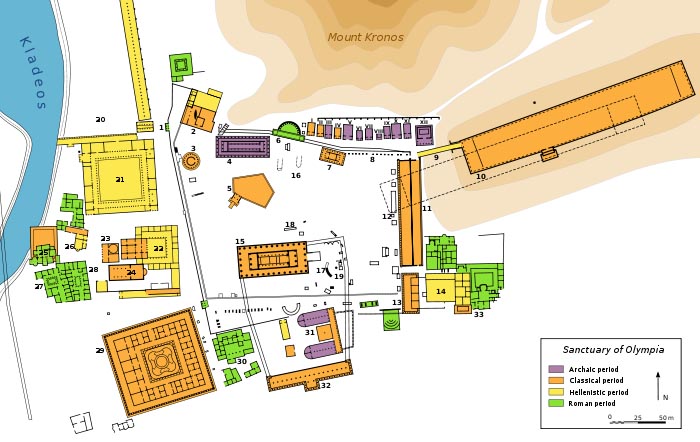
The Stones of Greece
The Peleponnisos
Eleia
Google-Map
Olympia, the Altis****
present
buldings 500BC-200 AD

1: North-East Propylon – 2: Prytaneion – 3: Philippeion – 4:
Temple of Hera – 5: Pelopion – 6: Nymphaeum of Herodes Atticus –
7: Metroon,, – 8: Treasuries – 9: Crypt (arched way to the
stadium) – 10: Stadium – 11: Echo stoa – 12: Building of
Ptolemy II and Arsinoe – 13: Hestia stoa – 14: Hellenistic
building – 15: Temple of Zeus – 16: Altar of Zeus – 17: Ex-voto
of Achaeans – 18: Ex-voto of Mikythos – 19: Nike of Paeonius –
20: Gymnasion – 21: Palaestra – 22: Theokoleon – 23: Heroon –
24: Phidias' workshop and paleochristian basilica – 25: Baths of
Kladeos – 26: Greek baths – 27 and 28: Hostels – 29: Leonidaion
– 30: South baths – 31: Bouleuterion – 32: South stoa – 33:
Villa of Nero
Treasuries. I: Sicyon – II: Syracuse – III:
Epidamnus ? – IV: Byzantium ? – V: Sybaris ? – VI: Cyrene ? –
VII: Unindentified – VIII: Altar ? – IX: Selinunte – X:
Metapontum – XI: Megara – XII: Gela
Plan Wikipedia
The Altis is the sacred sanctuary of Olympia. Its boundaries were marked in the north by the hill of Kronos and to the east, west and south by a low wall called the peribolos.
In the archaic and geometric periods, the peribolos was a low hedge and the Altis itself was a sacred grove. Votive offerings to the gods would have been hung from trees or placed in niches at the base of the hill of Kronos. There were no temples for worship.
The only manmade structures were altars and the burial tumuli of Pelops and Hippodameia, one of the earliest identifiable cults of Olympia. Most prehistoric finds were at the base of the hill of Kronos, father of the gods, which suggests that his cult was also of major importance to the early sanctuary. There is also evidence for the worship of Gaia, the earth and Rhea, the mother of the gods.
Of these cults, only two have later temples/shrines which survive in the archaeological record. The Pelopion was built as a shrine to Pelops as one of the mythical founders of the Olympic Games. It was remodelled in the sixth century BC, changing its enclosure from circular to pentagonal.
In the fourth century BC, the Metroon or temple of Rhea was constructed. A Doric temple, only the stylobate and parts of the stone entablature survive. Later, the temple became the home of the cult of the Roman emperors but it was constructed by the Greeks to honour Rhea as the mother of the gods and specifically the mother of Zeus, to whom the sanctuary had by that time become associated with.
The earliest ritual structure associated with Zeus was his altar. The
altar was not made of stone but rather constructed over time by an
accumulation of ashes from sacrifices to the god and the hearth of
the Prytaneion. It was destroyed after the demise of the sanctuary
but was situated south east of the temple of Hera.
Text from
suite101.com
Opympia,
Hera Temple ****
7th cent-450 BC

The columns of the Hera Temple, RWFG 1953
The Olympic Heraion
The oldest and best preserved temple building in the Altis, the temple of Hera can be dated to the seventh century BC.
At the foot of the hill of Kronos, it was originally dedicated to both Zeus and Hera, until a larger, more impressive building was dedicated to Zeus.
The temple was long and narrow and it is now believed to have been built in one phase. Although only the foundations and part of the cella which housed the statue of the goddess survive, it is possible to reconstruct it from the fragments on the site. The lower walls of the temple were made from limestone, topped with an upper layer of unbaked bricks. A wooden entablature and a roof of terracotta tiles were held up by a series of Doric columns.
Originally wooden, these columns were replaced over time with stone versions. Each column reflected the Doric fashion of the time it was erected. In this way, the temple of Hera is a record of the development of the Doric style.
Of the statues of the gods, only the plinths remain and the head of
Hera’s statue, which was discovered when the temple was excavated.
Also found within the temples ruins was the Hermes of Praxiteles,
made as an offering to the goddess.
Text from suite101.com
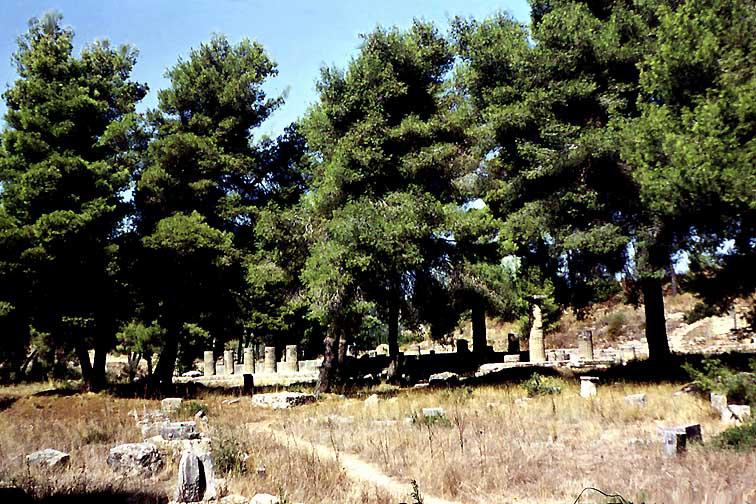
Hera temple in late September RWFG 1953.
Overgrown with pine trees grand-uncle Dörpfeld's excavations in the
altis have become one of the loveliest archeological sites in
Greece.
Wikipedia
Olympia,
Temple of Zeus***
470-457 BC
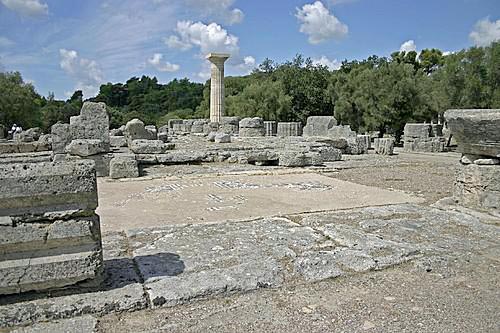
Temple of the Olympian Zeus, Panoramio
It was not until the early classical period that Zeus acquired his own temple in his sanctuary. The temple, which was built between 470-457BC by Libon of Elis was larger than Hera’s archaic temple and indeed any other classical temple in the Peloponnese and the Greek mainland.
From what remains on the site and the descriptions of Pausanias, it seems Zeus’s temple measured 64m x 268m and was a Doric style temple. It was built of a limestone conglomerate covered with stucco and Parian marble. The pillar lined portico featured 13 columns down the long side and 6 on the short side. The roof pediment was 63x95 feet. Of this, the pediment friezes survive in pieces and have been carefully reconstructed, along with the temple metopes in the museum of Olympia.
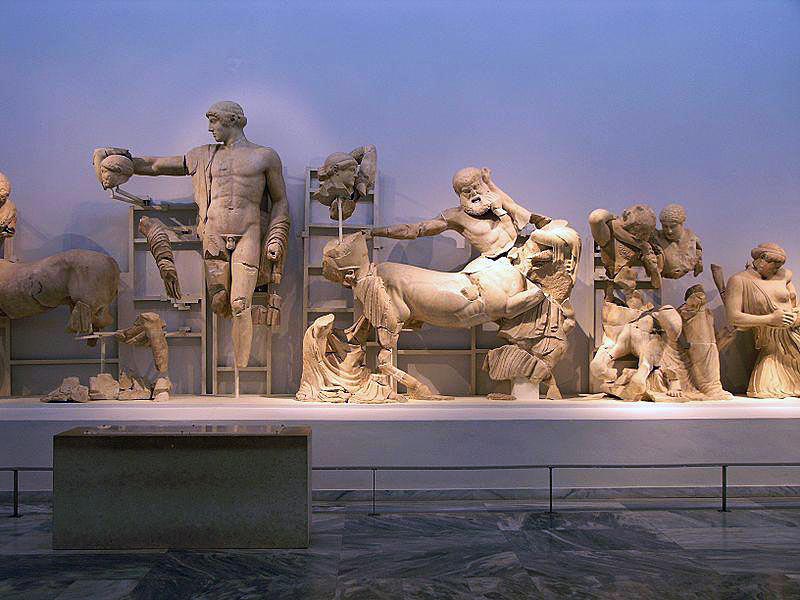
The sculptured ornaments from the Western pediment of the Temple of Zeus. Photo caldanainternational
There were 42 figures decorating the 2 pediments of the temple, 12 metopes and the lion-headed water spouts running along the lengths of the temple. It is one of the best surviving ensembles from ancient Greek works of art. They belong to the "austere style" and date to the 1st half of the 5th century B.C.
The eastern pediment depicts the chariot race between Pelops and Oinomaos, and the central figure which dominates the work is of Zeus. The western pediment depicts the abduction of the Lapith women by Centaurs, and has Apollo as its central figure. The metopes bear the relief representation of Hercules' labours. These sculptures were made during the 5th century B.C.
Old Olympia Museum

The old Museum built by Arthur Furtwängler and Barbara's uncle
Wilhelm Dörpfeld - is now closed.
For a history of the early
excavations see Latsis'
Catalogue of Olympia, pages 24-27
Photo Olympia
Greece.org
New Olympia Museum****
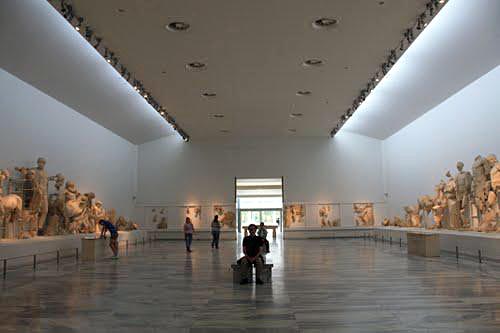
Sculptures of the Zeus Temple
The Archaeological Museum of Olympia, supervised by the Seventh
Ephorate of Prehistoric and Classical Antiquities, was reorganized in
2004 to meet modern museological standards
Latsis'
Catalog of the Olympia Museum
Wikipedia
Alifeira,
Asclapius Sanctuary*
4th-3rd cent BC
35
km northwest of Andritsena (Bassae, which today is in Eleia))
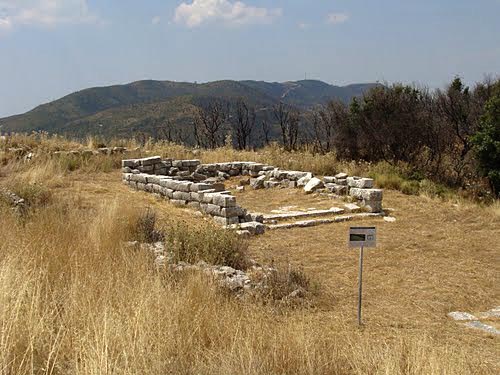
The Esculapeio of Alifeira, Panoramio
The ancient Arcadian town Alipheira was located in the Parrhasia country, 40 stadia (about 8 km) from ancient Heraea. It took part in the colonization of Megalopolis in 371 BC and was member of the Arcadian League. The name originates from Alipheros, son of Lycaon. In the city there were sanctuaries of Athena and Asclepius. In 224 BC Lydiades, tyrant of Megalopolis, gave the town to the Eleans. It was taken by Philip V of Macedon in 219 BC after a long siege, and later it joined the Achaean League and minted its own currency. Later, the city was subject to the Romans.
The first excavations were done by Anastasios Orlandos in 1932. In
the ancient city the temples of Athena and Asclepius, the acropolis,
the cemetery wall and some buildings have been found.
Wikipedia
Alifeira, Athena Temple*
4th
cent BC

Alifeira, Athena Temple, Panoramio